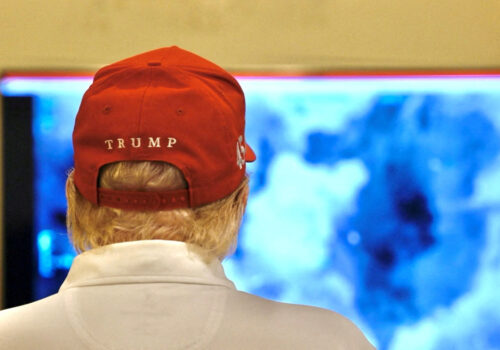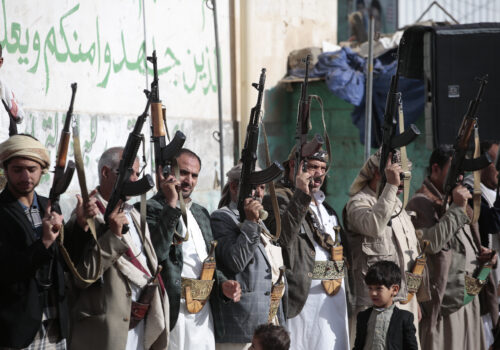Iran’s shadow looms large over the Houthi ceasefire
It’s too soon for another US “mission accomplished” in the Middle East.
President Donald Trump this month announced a halt to US airstrikes against Yemen’s Houthi rebels, claiming the group “capitulated” and would cease targeting American vessels and Red Sea traffic.
But a Washington victory lap now, after more than fifty straight days of preemptive military force against the Iran-backed terror group, would be premature. After all, no ceasefire is born of a political vacuum. Senior Iranian officials who were involved in the Omani-mediated ceasefire swayed the Houthis to cease attacking US assets, revealing Tehran’s continued command and control over its proxy’s strategic decisions rather than any genuine Houthi concession.
While presented as a US-Houthi agreement, the ceasefire is consistent with a well-established pattern by Iran: directing proxies to dial violence up or down as strategic circumstances demand, all while benefiting from the perception of these groups being autonomous, as long seen in the cases of Lebanese Hezbollah or Shiite militias in Iraq. This duplicitous approach, extending a diplomatic handshake while concealing the knife of proxy warfare, is precisely how Iran extends its influence beyond its actual capabilities.
Over the past decade, Iran has become the Houthis’ most important foreign backer, providing them with missiles, drones, and other military-grade components. Additionally, Tehran aides Houthi sanctions-busting and illicit revenue generation efforts. Through the Houthis, Iran has put state-level military capabilities into the hands of a non-state actor in Yemen.
However, Washington’s relentless airstrikes have decimated Houthi military infrastructure since launching in March, targeting missile depots, command nodes, and radar systems on a scale not seen in Yemen since the early days of Saudi Arabia’s 2015 intervention. US officials say their forces have struck over a thousand targets in just seven weeks.
Tehran is buying time
For the Islamic Republic, preserving assets and living to fight another day is something of an art form. Tehran is cognizant of growing vulnerabilities at home and abroad, and is offering tactical concessions to create the impression of a “win” for its adversaries, particularly in Trump’s Washington. For instance, during the Vienna nuclear talks, Iranian officials repeatedly stated they had shown “tactical flexibility on technical points” while maintaining “core red lines.” Iran’s foreign minister insisted that the country’s strategic objectives remained intact. This pattern mirrors Iran’s behavior during the 2015 nuclear deal, where it accepted temporary limits on its nuclear program but refused to negotiate over its ballistic missile arsenal or regional proxy networks. This approach allows Tehran to benefit from diplomatic engagement, even short-term ceasefires, without altering its core security objectives.
Oman’s Foreign Minister Badr Albusaidi officially announced the US-Houthi agreement as a means to ensure “freedom of navigation” in the Red Sea. Saudi Arabia immediately welcomed the truce as a step toward “a comprehensive political solution to the Yemeni crisis” that could ensure “security and stability for Yemen and the wider region.”
But behind Riyadh’s endorsement lies war fatigue against an Iranian proxy, and the challenge of navigating often-conflicting US-Middle East policy priorities across four presidential administrations. After nearly a decade of Houthi conflict and no meaningful military victory, Saudi Arabia moved from contestation to containment. In 2023, it even restored diplomatic ties with the Houthis’ patron, the Islamic Republic, signaling a broader strategic retreat. Therefore, what began in 2015 as a campaign to dislodge and disarm the Houthis has ended with quiet disengagement and a more potent Houthi threat on the Kingdom’s doorstep. Iran, meanwhile, pursued a strategy of endurance rather than dominance, arming and advising its proxies at low cost while watching Saudi Arabia bleed resources and legitimacy. Each year the conflict dragged on, Tehran’s model of indirect warfare gained ground. Tehran, therefore, never really needed to win; it just needed to outlast Riyadh.
Critically, the new Omani-mediated ceasefire’s timing aligns perfectly with another Omani diplomatic endeavor in the region: indirect nuclear negotiations between Iran and the United States. According to sources cited by CNN, the Houthi ceasefire “aimed at building momentum for nuclear deal talks with Iran.”
By being the driving force behind the Houthi ceasefire, Tehran can frame its regional weakness as goodwill, thereby strengthening its case for something in return. This tactic is not new. In 2022, as former US President Joe Biden’s administration pursued renewed nuclear talks, rocket and drone attacks on US assets in Iraq dropped sharply. Biden cited the lull as evidence of regional stability, even as senior Iranian officials, including IRGC commander Esmail Qaani, made repeated visits to Iraq to manage militia activity and shape political outcomes. The timing suggests Tehran used a tactical pause in proxy activity to support its diplomatic goals, without altering its core posture.
This calculated diplomatic maneuver also seemingly comes in response to the Trump administration’s escalating maximum pressure campaign. This month, the US president demanded an immediate end to “all purchases of Iranian oil, or petrochemical products,” and later, he sanctioned an independent refinery in China processing Iranian crude oil. Trump has recently insisted on “total dismantlement” of Iran’s nuclear program, a position bolstered by his hawkish fellow Republicans in the US Congress.
SIGN UP FOR THIS WEEK IN THE MIDEAST NEWSLETTER
Beyond using the ceasefire to generate leverage, Tehran faces the more immediate priority of preventing the collapse of its Houthi proxy. The Houthi insurgency in Yemen, including the 2015 takeover of the capital Sana’a, provided Iran a low-cost opportunity to deepen its footprint in the Arabian Peninsula, offset its regional rival Saudi Arabia, and expand the scope of maritime harassment from the Persian Gulf to the Red Sea.
This diplomatic intervention follows Iran’s established approach in Lebanon in 2024, where it sought a ceasefire for Hezbollah when Israel’s military campaign imposed defeat after defeat on the Iran-backed terror group. With Hamas flattened in Gaza, much of Hezbollah’s leadership crippled, and the loss of Iran’s sole state partner in the Middle East with Bashar al-Assad’s rule in Syria, Tehran cannot afford to lose another leg of its so-called “Axis of Resistance.”
Israel: The deliberate exception
While the Houthis ostensibly negotiated directly with the United States through Omani intermediaries to get a reprieve from the relentless strikes, Tehran’s fingerprints are evident in the selective scope of the agreement. The ceasefire specifically excludes Israel, with the Houthis’ chief negotiator, Mohammed Abdulsalam, explicitly stating that it “does not address operations against Israel in any way.” This surgical separation of US and Israeli security aligns perfectly with Iran’s regional strategy of isolating Israel while reducing direct pressure on its proxy network, but also with the Houthis’ own narrative of resistance, in which attacks on Israel serve a distinct ideological and symbolic purpose.
This carve-out proved especially useful in mid-May when they issued direct threats against the Israeli port city of Haifa, maintaining pressure on Israel while staying technically within the bounds of their agreement with Washington. Such targeted provocations highlight the fundamental problem with partial regional ceasefires—they merely redirect rather than resolve hostilities, allowing Iran’s proxy network to strategically focus its aggression while creating the illusion of diplomatic progress.
Moreover, Tehran may be looking to press on a cleavage that already exists between Washington and Jerusalem on regional security priorities. For example, while Washington was seeking an off-ramp, Israel escalated its military campaign, striking Houthi targets, Yemen’s power facilities, and destroying Sanaa’s international airport. The Houthis’ declaration of an “aerial blockade” against Israel just two days before finalizing the US ceasefire similarly signals this calculated pivot, abandoning maritime attacks on Washington’s interests while intensifying focus on Israeli targets.
Ceasefire as a tactical advantage for the Houthis
For the Houthis, ceasefires are less an end to conflict than extensions of it by other means. Like in past truces, pauses allow for regrouping, recruitment, and rearmament—often with more lethal outcomes. The illusion of calm often precedes a sharper escalation.
During the previous ceasefire with Saudi Arabia, for example, the Houthis unveiled advanced military hardware from Iran during parades, some of which they later used in attacks from November 2023 onward. This ceasefire gives the Houthis crucial time to recover and rearm, while allowing Tehran to preserve its last effective pressure point on the Arabian Peninsula and on another strategic chokepoint, the Bab al-Mandeb Strait and the Red Sea.
Iran’s dual “knife and a handshake” strategy has repeatedly proven effective. The Houthis may have temporarily suspended their attacks on US vessels, but Tehran has neither abandoned its regional ambitions nor its determination to drive wedges between the United States and its allies. This calculated maneuver serves as a stark reminder that apparent de-escalation often masks preparation for future conflict.
If Washington and its regional partners want to blunt Tehran’s influence, they must stop treating tactical pauses as strategic breakthroughs. Iran’s proxies do not need sustained battlefield victories to succeed—only time, space, and plausible deniability. Meaningful pushback requires more than just airstrikes or ceasefire diplomacy. It demands a coordinated strategy that recognizes the interconnectedness of Iran’s proxy network and denies it the ability to regroup under the cover of de-escalation. Anything less risks repeating the same pattern: temporary quiet, followed by deeper entrenchment.
Fatima Abo Alasrar is a Senior Analyst at the Washington Center for Yemeni Studies.
Behnam Ben Taleblu is the senior director of the Iran program at the Foundation for Defense of Democracies (FDD) in Washington, DC.
Further reading
Mon, May 5, 2025
How China turned the Red Sea into a strategic trap for the US
MENASource By
Beijing’s proxy warfare turns global trade routes into battlefields that the United States struggles to defend.
Thu, Apr 10, 2025
No, Iran didn’t abandon the Houthis. It just wants Trump to think so.
MENASource By
Instead of interpreting Iran's narrative shift as a break from the Houthis, we might see it as tactical storytelling. And the story's working.
Fri, Mar 14, 2025
The United States’ Houthi terrorist designation unmasks Russia’s Yemen strategy
MENASource By
Yemen's Houthi rebels have become a tool of foreign powers, shifting from an Iran proxy to a Russian asset.
Image: Protesters, predominantly Houthi supporters, demonstrate to show solidarity with the Palestinians in the Gaza Strip and to condemn U.S. strikes in Yemen, in Sanaa, Yemen May 16, 2025. REUTERS/Adel Al Khader



